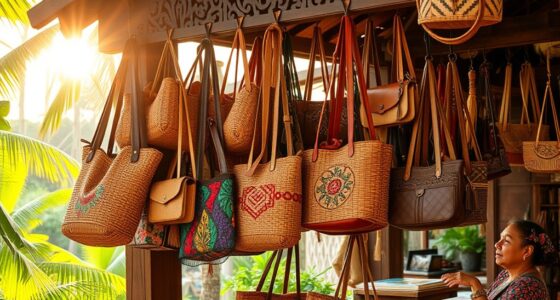Fast fashion has rapidly transformed the handbag market by prioritizing speed, affordability, and trendy designs over craftsmanship and quality. This shift diminishes the demand for traditional artisans, leading to a decline in skilled craftsmanship and cultural heritage. Mass production often results in lower quality, environmental harm, and unethical labor practices. However, innovative technologies and sustainable collaborations are helping artisans adapt and preserve skills. You can learn how these changes are shaping a more balanced future for handbag craftsmanship.
Key Takeaways
- Fast fashion’s emphasis on rapid, low-cost production undermines traditional handbag craftsmanship and diminishes artisanal skills.
- The industry’s focus on speed reduces quality, compromising craftsmanship details like hand-stitching and material integrity.
- Mass production driven by fast fashion erodes cultural heritage and leads to the disappearance of skilled handbag artisans.
- Environmental costs increase due to waste, pollution, and non-biodegradable materials used in quick, low-quality handbag manufacturing.
- Innovation and sustainable practices are emerging to preserve craftsmanship while adapting to fast fashion’s market demands.
The Rise of Fast Fashion and Its Market Influence
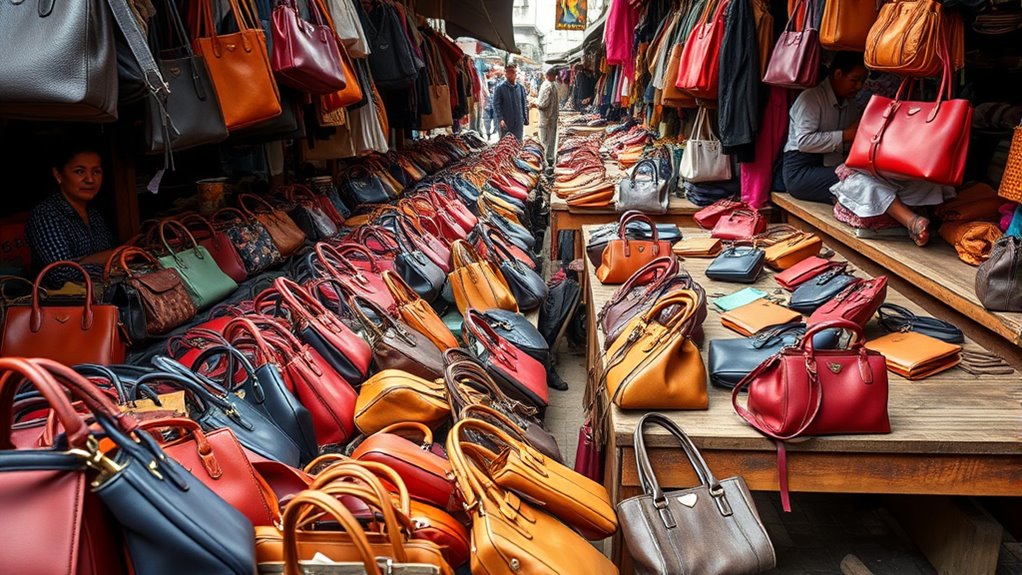
The rise of fast fashion has dramatically transformed the clothing and accessories industry, making trendy designs quickly available at low prices. This shift challenges traditional luxury branding, pushing brands to adapt their marketing strategies to stay relevant. Fast fashion retailers leverage aggressive marketing tactics, emphasizing affordability and immediacy to attract a broad audience. As a result, consumers now expect access to stylish, on-trend handbags without the high price tag, impacting the demand for handcrafted, luxury pieces. The emphasis on rapid production and mass appeal has shifted focus away from artisanal craftsmanship. This market influence forces luxury brands to rethink their branding approach, balancing exclusivity with the need to compete against fast fashion’s speed and affordability. Additionally, the focus on quick turnaround times often leads to compromises in color accuracy and material quality, further undermining traditional craftsmanship standards.
Decline of Traditional Handbag Artisanship
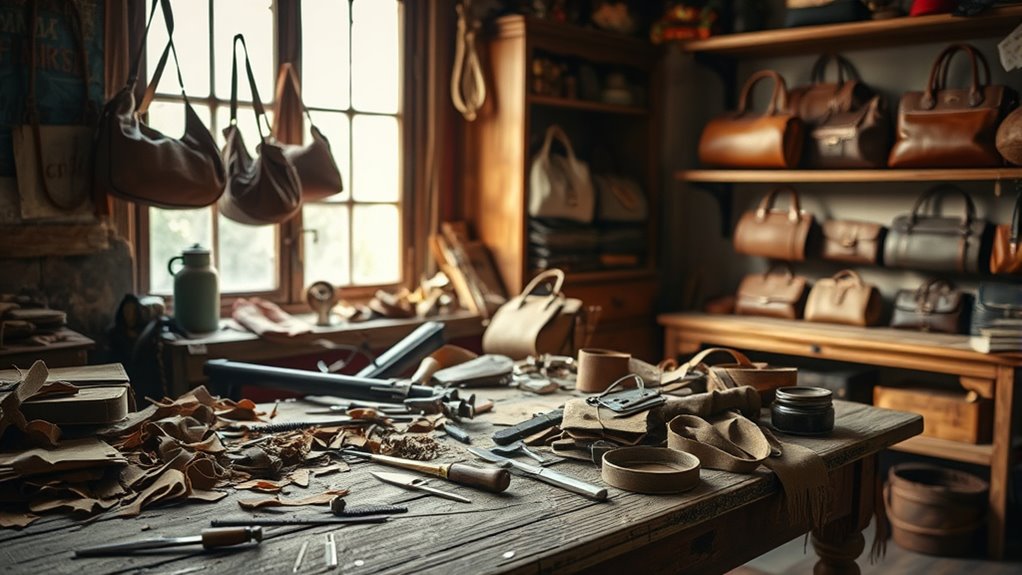
You may notice that many skilled handbag artisans are disappearing as mass-produced options take over. This shift erodes the craftsmanship techniques passed down through generations and threatens cultural heritage. Without support, these traditional methods risk becoming lost forever. Additionally, as automation and technological advancements continue to influence industries, the preservation of artisanal skills becomes increasingly challenging.
Erosion of Skilled Techniques
As fast fashion’s rapid production cycles prioritize cost and speed, skilled handbag artisanship faces a steady decline. In this environment, the intricate art of handbag design suffers as manufacturers favor quick, mass-produced models over handcrafted pieces. The erosion of artisan skill becomes evident as traditional techniques are replaced by automated processes, reducing the need for expert craftsmanship. You may notice fewer artisans practicing time-honored methods like hand-stitching or detailed finishing, which once defined quality. Instead, the focus shifts to faster, cheaper alternatives that undermine the craftsmanship behind each bag. This shift not only diminishes the uniqueness of handmade handbags but also threatens the preservation of refined techniques that have been passed down through generations. Additionally, the rise of fast fashion has led to a decline in My Dog’s Names that reflect traditional craftsmanship, further impacting the cultural heritage of handbag making.
Loss of Cultural Heritage
Fast fashion’s emphasis on quick production has led to the decline of traditional handbag artisanship, eroding centuries-old cultural practices. As mass-produced bags dominate the market, skilled artisans find fewer opportunities to practice and pass down their techniques, threatening cultural preservation. This shift undermines artisanal heritage, which reflects local histories, craftsmanship, and identities. When traditional methods fade, entire cultural narratives risk being lost forever. You might notice fewer handmade bags that showcase unique craftsmanship and storytelling. The loss of these practices diminishes diversity in design and quality, making fashion less authentic and more homogenized. Preserving artisanal heritage requires valuing craftsmanship over speed, supporting artisans, and recognizing the cultural significance embedded in handcrafted handbags. Without intervention, centuries of craftsmanship could vanish, leaving cultural heritage fragmented and forgotten. Supporting traditional craftsmanship is essential to sustain this cultural legacy for future generations.
Quality Versus Quantity: The Cost of Mass Production
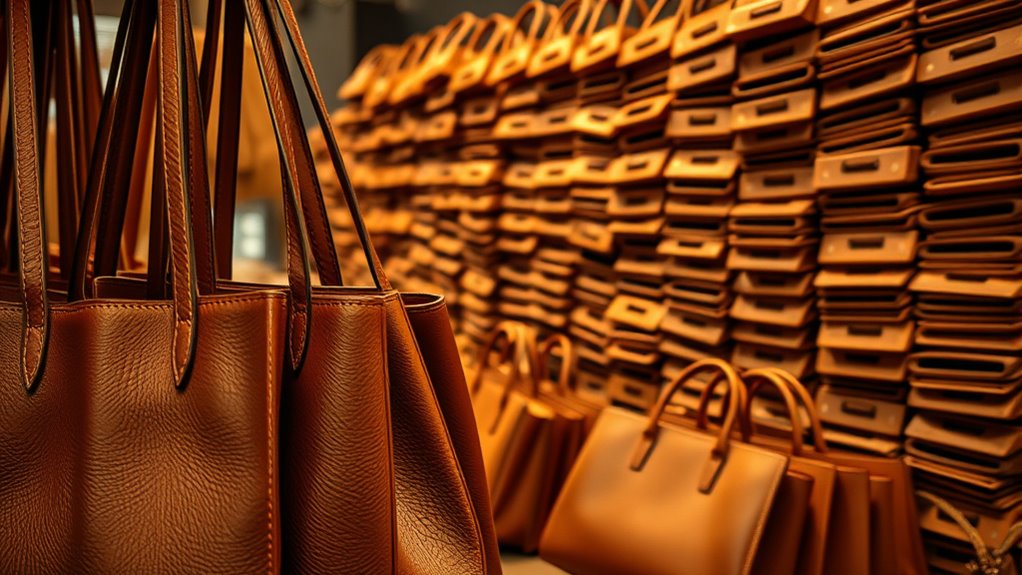
When mass production prioritizes speed and volume, the quality of each handbag often suffers. This approach leads to deteriorating craftsmanship and increased environmental harm from waste and pollution. You need to contemplate whether quantity truly compensates for the hidden costs involved.
Deterioration of Craftsmanship
Mass production driven by fast fashion has increasingly prioritized quantity over quality, leading to a noticeable decline in handbag craftsmanship. As factories focus on speed and volume, skilled artisans find their expertise undervalued, and traditional techniques fade away. This shift hampers craftsmanship preservation, making handcrafted details rare and less refined. You might notice that mass-produced handbags lack the durability and unique character of artisanal pieces. The artisan revival seeks to counter this trend by emphasizing quality and skill, but fast fashion’s dominance makes it harder to sustain true craftsmanship. Ultimately, the deterioration of craftsmanship compromises the integrity and richness of handbag making, eroding the artistry that once set high-quality pieces apart from mass-market products. Additionally, Gold IRA Fees Demystified have shown how transparency and cost management are crucial in preserving long-term value, much like maintaining high craftsmanship standards in handbag creation.
Environmental Impacts Increase
The environmental costs of prioritizing quantity over quality have become more evident as mass production methods expand. Fast fashion brands often rely on cheap, non-biodegradable materials, increasing landfill waste. Recycling initiatives aim to mitigate this impact, but their effectiveness remains limited when production emphasizes volume. Using eco-friendly materials, like recycled leather or plant-based fabrics, helps reduce environmental harm, but many manufacturers overlook these options to cut costs. The relentless push for rapid, high-volume output accelerates resource depletion and pollution. Vetted As a result, your choices as a consumer influence this cycle—favoring brands that invest in sustainable practices. By supporting companies committed to recycling initiatives and eco-friendly materials, you contribute to lowering the environmental footprint of handbag manufacturing and promoting responsible craftsmanship.
Environmental and Ethical Concerns in Fast Fashion
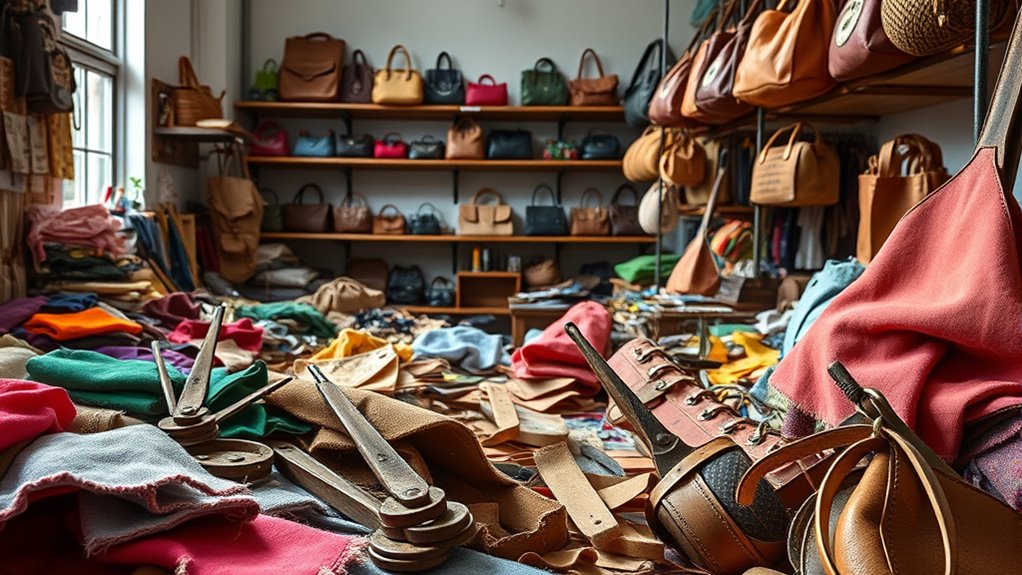
Fast fashion’s rapid production cycles often come at a high environmental and ethical cost. You might not see the full picture, but supply chain transparency reveals the darker side—pollution, waste, and resource depletion. Many fast fashion brands prioritize speed over sustainability, often neglecting fair labor practices. Workers in low-cost countries face unsafe conditions, long hours, and meager wages. These unethical practices contribute to environmental damage, as factories dump toxic chemicals and discard excess materials. By ignoring transparency, brands avoid accountability, making it harder for consumers like you to make informed choices. Addressing these issues requires a shift toward ethical sourcing and greater openness about production processes. Incorporating Gold IRA Rollovers as part of a diversified investment strategy can also help support more sustainable economic models. Your awareness can help push brands to adopt more sustainable and fair practices, ultimately benefiting both the environment and garment workers.
Consumer Preferences and the Demand for Instant Gratification

Your desire for quick, affordable fashion options fuels a culture of instant gratification that shapes consumer behavior. You want trendy handbags you can buy today and wear tomorrow without waiting. This need for immediate satisfaction drives you to seek out fast fashion brands that offer low prices and rapid turnover. As a result, you’re less inclined to value craftsmanship or durability, preferring new styles that satisfy your urge for novelty. This behavior encourages brands to prioritize quick production cycles over quality, impacting the longevity of handbags. Your demand for instant gratification reinforces a cycle where consumers constantly seek new items, reducing appreciation for timeless craftsmanship. This trend also diminishes the perceived value of handbag craftsmanship, leading to a decline in artisanal skills and the preservation of traditional techniques. Ultimately, this shift in consumer preferences influences the entire industry, favoring speed over artisanal skill.
Innovations and Adaptations Within Handbag Craftsmanship
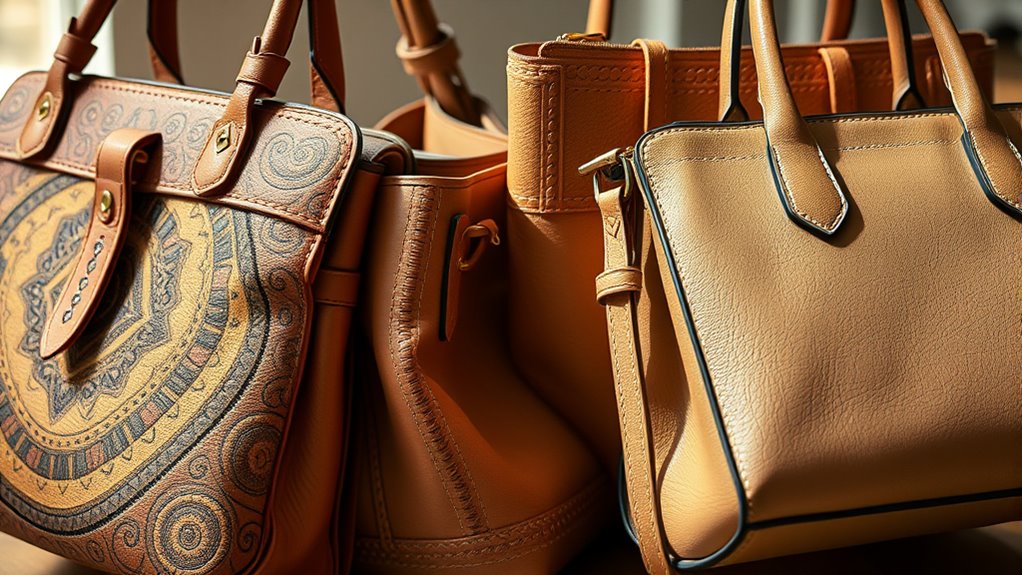
Despite the pressure to produce handbags quickly and cheaply, artisans and designers are finding innovative ways to adapt traditional craftsmanship. Technological innovations like 3D printing and laser cutting streamline complex processes, saving time without sacrificing quality. Adaptive techniques, such as modular design and lightweight materials, help artisans meet modern demands while maintaining craftsmanship standards. Digital tools also enable artisans to experiment with new textures, patterns, and finishes, expanding creative possibilities. These innovations allow craftsmen to stay competitive in a fast-paced market, blending age-old skills with modern technology. For example, beach destinations are incorporating sustainable and eco-friendly materials into their designs to appeal to environmentally conscious consumers. As a result, handbag craftsmanship evolves, balancing tradition with innovation to meet consumer expectations for both quality and speed. This adaptive approach guarantees craftsmanship remains relevant amid changing industry dynamics.
The Role of Sustainable Practices in Preserving Craftsmanship
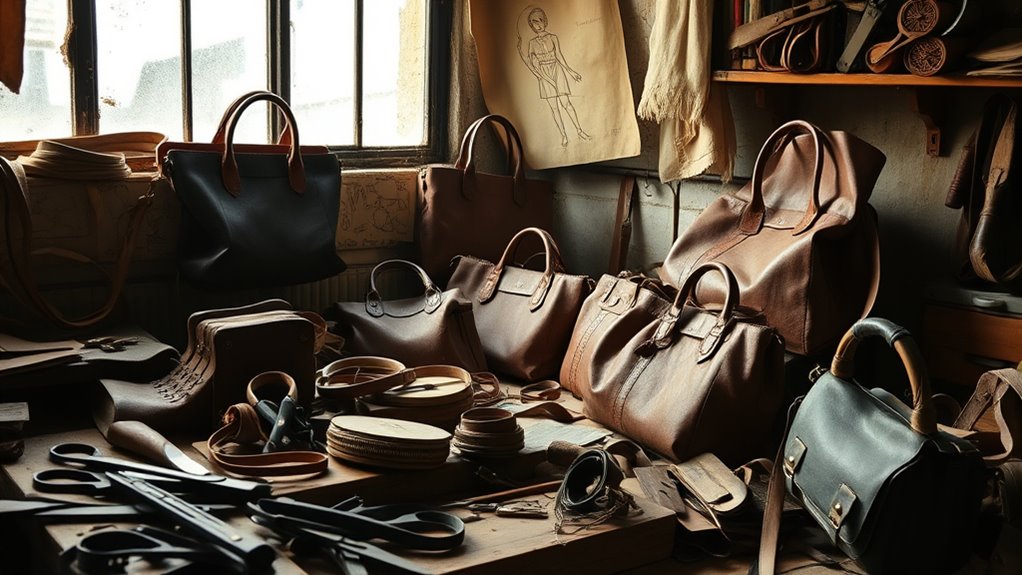
As handbag artisans integrate modern technologies and innovative techniques, they also recognize the importance of sustainable practices to preserve craftsmanship for future generations. You can see this in their commitment to ethical sourcing, ensuring that materials come from responsible suppliers who prioritize fair labor and environmental standards. They also choose eco-friendly materials, like vegetable-tanned leather or recycled fabrics, reducing environmental impact. These sustainable practices help maintain the integrity of traditional craftsmanship while addressing modern concerns about sustainability. By focusing on ethical sourcing and eco-friendly materials, artisans not only protect the environment but also support the longevity of their craft. Additionally, incorporating AI-driven data analysis allows artisans to better understand market trends and consumer preferences, ensuring their work remains relevant and sustainable in a rapidly changing industry. Your appreciation for handbags that emphasize sustainability reflects a growing movement to honor craftsmanship and promote responsible fashion.
Collaborations and New Business Models Supporting Artisans
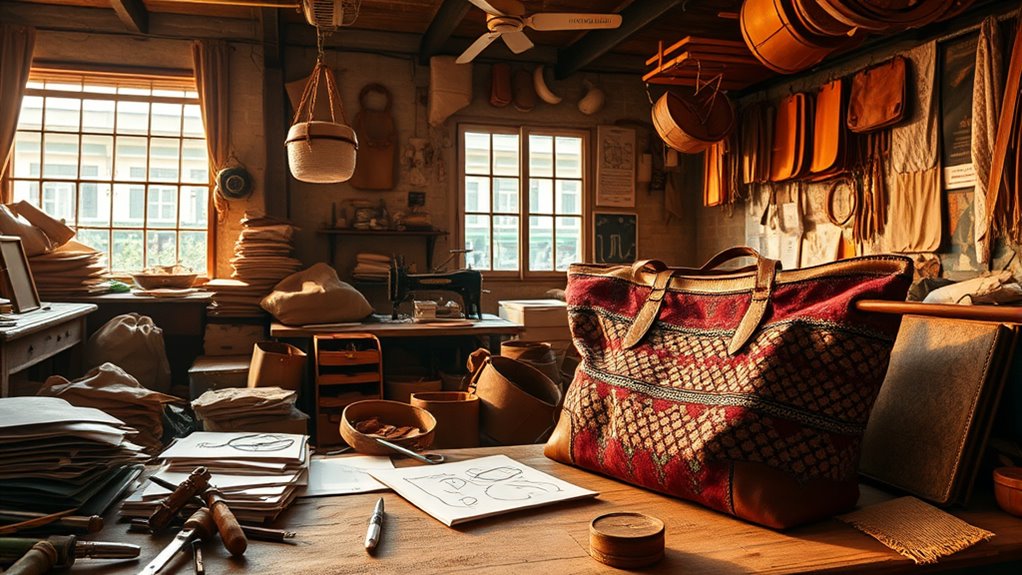
Collaborations between traditional handbag artisans and fashion brands, designers, or social enterprises are creating new opportunities to support craftsmanship and expand market reach. These artisan collaborations blend heritage skills with innovative ideas, allowing artisans to showcase their work to wider audiences. New business models, like direct-to-consumer platforms and social enterprise initiatives, empower artisans by providing fair wages and sustainable income streams. Such partnerships foster skill preservation while adapting to modern market demands. They also open doors for artisans to access resources, training, and exposure previously unavailable, strengthening their craft. By embracing these collaborations and new models, you help ensure craftsmanship remains relevant and resilient, balancing tradition with innovation in a rapidly changing fashion landscape.
Future Outlook: Balancing Speed, Sustainability, and Craftsmanship
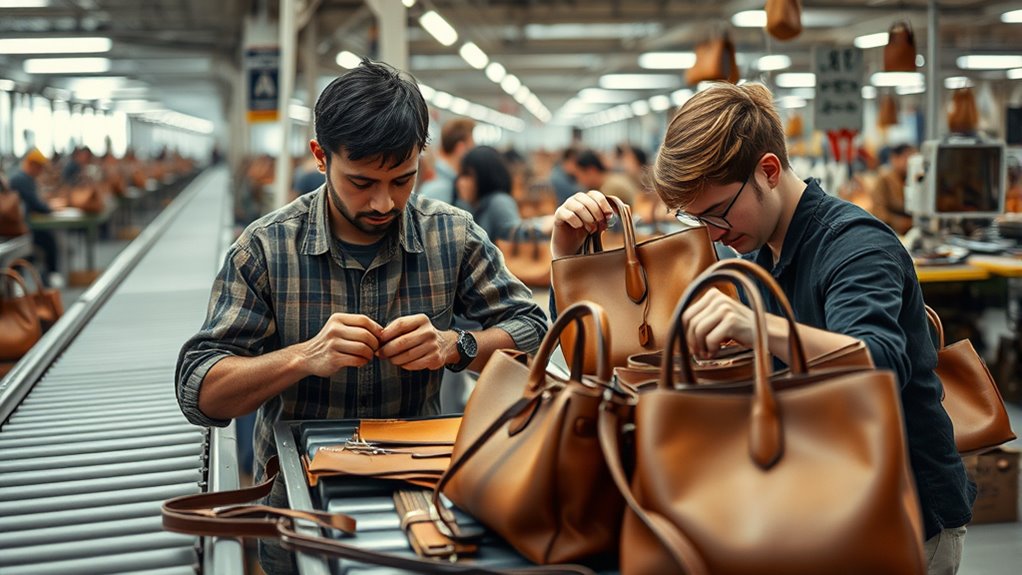
Balancing the demands of fast fashion with the principles of sustainability and craftsmanship poses a significant challenge for the future of handbag artisans. Technological integration offers a way forward, allowing artisans to streamline production without sacrificing quality. Digital tools can optimize materials and reduce waste, aligning with sustainable goals. At the same time, designer collaborations can bridge the gap between speed and craftsmanship, creating limited editions that honor traditional techniques while meeting market demands. You’ll need to embrace innovation while preserving artisanal skills, fostering a new era where speed doesn’t compromise integrity. This balance requires strategic partnerships, smart use of technology, and a commitment to sustainability, ensuring that handbag craftsmanship not only survives but thrives amidst evolving fashion trends.
Frequently Asked Questions
How Does Fast Fashion Influence Consumer Perceptions of Handbag Quality?
Fast fashion shapes your perception of handbag quality by setting high consumer expectations for affordability and trendiness. However, this often leads you to perceive durability as less important, as you might prioritize the latest styles over craftsmanship. When fast fashion dominates, you may view handbags as less lasting, valuing quick access to new designs rather than investing in pieces with true craftsmanship. This shift impacts how you judge a handbag’s overall quality.
What Are the Economic Impacts on Traditional Artisans Due to Fast Fashion Trends?
You might notice that fast fashion trends cause artisan decline, as traditional handbag makers struggle to compete with low prices. This price suppression pressures artisans to cut costs, often sacrificing quality and craftsmanship. As a result, many skilled artisans face reduced income or abandonment of their craft, leading to a loss of cultural heritage and craftsmanship expertise. Fast fashion’s economic impact diminishes the sustainability of traditional handbag craftsmanship.
Can Sustainable Practices Effectively Replace Mass Production in Handbag Manufacturing?
You might wonder if sustainable practices can truly replace mass production in handbag manufacturing. Evidence suggests that using sustainable materials and ethical sourcing can create high-quality, eco-friendly handbags that appeal to conscious consumers. While it requires more effort and investment, this approach fosters craftsmanship, reduces environmental impact, and promotes fair labor practices. Ultimately, sustainable methods can effectively meet demand and reshape the industry, proving that quality and sustainability can go hand in hand.
How Do Collaborations Between Brands and Artisans Affect Craftsmanship Preservation?
You see that artisan collaborations play a vital role in craftsmanship preservation. When brands partner with skilled artisans, they help maintain traditional techniques and unique craftsmanship that might otherwise fade away. These collaborations support local communities and guarantee craftsmanship stays alive. By valuing and promoting authentic artisan work, you contribute to preserving craftsmanship while creating distinctive, high-quality handbags that stand out from mass-produced alternatives.
What Future Technologies Could Revolutionize Handbag Craftsmanship Sustainability?
You might find that future technologies could revolutionize handbag craftsmanship sustainability, proving the theory that innovation can save traditional skills. Biodegradable materials could replace plastics, reducing environmental footprints. Meanwhile, 3D printing allows precise, less wasteful production, empowering artisans to craft with minimal waste. These advancements could preserve craftsmanship while promoting eco-friendly practices, proving that technology and tradition can unite for a more sustainable future.
Conclusion
As you navigate the shifting landscape of fashion, remember that every handbag you choose weaves a story—either of fleeting trends or timeless craftsmanship. By supporting artisans and embracing sustainability, you become a guardian of artistry’s delicate dance against the rushing tide of fast fashion. Your choices ripple outward, shaping a future where quality and conscience grow roots, turning fleeting fads into enduring masterpieces that stand the test of time’s relentless march.


